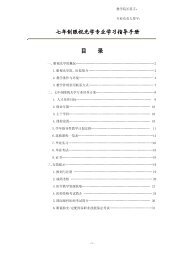Refractive Lens Surgery
Refractive Lens Surgery
Refractive Lens Surgery
You also want an ePaper? Increase the reach of your titles
YUMPU automatically turns print PDFs into web optimized ePapers that Google loves.
Chapter 11 Presbyopia – Cataract <strong>Surgery</strong> 107<br />
Table 11.2. Findings in 30 eyes of 30 patients at different time points following implantation of the 1CU accommodative<br />
posterior chamber intraocular lens. Indicated are mean, standard deviation, median and range<br />
Three months Six months Twelve months<br />
Spherical equivalent –0.28±0.54 –0.29±0.52 –0.21±0.54<br />
of distance refraction (D) –0.25, –1.38 to +0.75 –0.25, –1.38 to +0.5 –0.25, –1.13 to +0.5<br />
Accommodative range 1.93±0.47 1.85±0.62 2.02±0.38<br />
determined by near point (D) 2.0, 1.0–2.78 1.85, 0.5–2.7 2.0, 1.32–2.56<br />
Anterior chamber depth (mm) 4.40±0.44 4.35±0.50 4.25±0.53<br />
4.47, 3.30–5.21 4.45, 3.30–5.23 4.30, 3.28–4.97<br />
Near visual acuity with best 0.41±0.15 0.37±0.12 0.39±0.11<br />
distance correction (Birkhäuser 0.4, 0.2–0.7 0.3, 0.2–0.6 0.4, 0.3–0.6<br />
reading charts in 35 cm)<br />
and corresponding Jaeger values<br />
(J3, J10–J1) (J7, J10–J1) (J3, J7–J1)<br />
Fig. 11.5. Box plots showing accommodative<br />
range (D) determined by near point at different<br />
time points after implantation of the new accommodative<br />
1CU posterior chamber intraocular lens<br />
in 15 patients. The boxes include 50% of measured<br />
values (between the 25th and 75th percentiles) and<br />
show the position of the median (horizontal line).<br />
The error bars indicate 1.5 times the interquartile<br />
distance from the upper and lower box edges<br />
Our results indicate that for up to 12<br />
months, the 1CU PCIOL shows no tendency<br />
of myopization, anterior movement of the<br />
lens optic or loss of distance-corrected near<br />
visual acuity. One possible explanation for<br />
these encouraging observations may be that<br />
we observed very little fibrosis of the capsular<br />
bag or the anterior and posterior lens capsule.<br />
This may be a result of the design of the<br />
1CU PCIOL and the fact that we carefully<br />
performed a well-centered round capsulorrhexis<br />
of 5 mm with the remaining anterior<br />
lens capsule circumferentially covering the<br />
rim of the PCIOL optic. Furthermore, we<br />
carefully observed inclusion and exclusion<br />
criteria that excluded eyes with potential<br />
zonular weakness and tendencies to develop<br />
increased fibrosis of the lens capsule, i.e.<br />
traumatic changes, pseudoexfoliation, and<br />
proliferative diabetic retinopathy.<br />
Based on our findings, we conclude that it<br />
is unlikely that problems such as anterior<br />
vaulting, anterior movement or dislocation of<br />
the 1CU PCIOL will occur after more than 12<br />
months. Nevertheless, we believe that further<br />
studies with longer follow-up and a randomized,<br />
masked, multicenter design are needed<br />
to analyze further the 1CU PCIOL with<br />
regard to long-term biocompatibility and<br />
accommodative properties.



